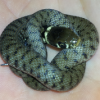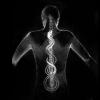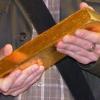Thanks MetaGene, surprised I can't locate that paper in PubMed or LibGen.
I've also found (2013) Evaluation of Metabolically Stabilized Angiotensin IV Analogs as Procognitive/Antidementia Agents which puts Dihexa through its paces.
Below I pull out interesting bits from the paper. Some of it goes over my head. It doesn't seem to indicate clearly the dosage and dosing pattern for optimal synaptogenesis. It looks as though a steady influx over a short period of time (a few days?) prompts new synapses to form. It doesn't seem to investigate the maximum effective dose. i.e. There is probably some dose level where HGF receptors are getting fully agonised by dihexa and synaptogenesis peaks. I can't find that info.
As regards risks, it looks as though one would need to investigate the HGF/c-Met pathway.
π
- - - - - - -
Introduction
Multiple studies have documented the ability of angiotensin IV (AngIV) and several AngIV analogs to facilitate long-term potentiation, learning, and memory consolidation (Braszko et al., 1988; Wright et al., 1999; Kramar et al., 2001; Lee et al., 2004); increase cerebral blood flow (Kramar et al., 1997); and provide neuroprotection (Faure et al., 2006). [...]
[AngioTensin IV agonises AngIV receptor which activates HGF/c-Met pathway.]
Dihexa Has a Long Circulating Half-Life
To begin to evaluate the potential clinical utility of dihexa, adult male Sprague-Dawley rats were administered 10 mg/kg dihexa intravenously and in-vivo pharmacokinetics were determined. An example of the resulting plasma concentration/time profile is shown in Supplemental Fig. 2. Dihexa exhibited rapidly decreasing plasma levels from 0 to 4 hours, suggesting that both distribution and elimination occurred during this period. After 4 hours, the rate of clearance declined and plasma levels became more stable, exhibiting a relatively linear rate of decline, suggesting a phase of pure elimination from 4 to 120 hours.
[...]
Dihexa Exhibits Procognitive Activity
The essential test of the success of the structural modifications incorporated into dihexa was whether it possessed procognitive activity like its parent compound Nle1- AngIV. Therefore, dihexa’s ability to reverse scopolamine-dependent deficits in the water maze performance was established. The initial study, which was simply tasked with verifying the procognitive activity of dihexa, entailed the direct brain delivery of dihexa via an i.c.v. cannula. The data presented in Fig. 3A confirm our expectation that dihexa would retain biologic activity. Both the low- and high-dose groups of dihexa yielded significantly improved performance when compared with the scopolamine group from day 2 of testing on (P < 0.001). The high-dose group was indistinguishable from the vehicle control group at all testing days (P > 0.05).
Since the ultimate goal of the project was to produce a clinically relevant molecule that could be delivered peripherally but still exhibit procognitive/antidementia activity, the effectiveness of both the intraperitoneal and oral delivery routes of dihexa administration were determined using the scopolamine model. As can be seen in Fig. 3, B and C, both delivery methods yielded the anticipated biologic activity. Furthermore, both studies indicated a clear dose-response relationship between the dose of dihexa and water maze performance. The high doses of each method of delivery (i.p. = 0.5 mg/kg per day; oral = 2.0 mg/kg per day) produced performances that were significantly improved over that seen in the scopolamine groups (P < 0.001) and indistinguishable from vehicle controls (P > 0.05).
Probe trials on day 9 were again used to evaluate the strength and persistence of the learned task. As can been seen in Fig. 4, A, B, and C, dihexa at its highest dose significantly (P < 0.001) increased the time spent in the target quadrant compared with the scopolamine-impaired groups, regardless of the delivery method used and was not different from nonscopolamine-treated controls (P > 0.05). In each case where multiple doses of dihexa were used, the probe trial data yielded a dose-response relationship similar to that observed for escape latencies.
[...]
Dihexa Induces Spinogenesis in Cultured Hippocampal Neurons
Recently, the procognitive effects of Nle1-AngIV, the parent compound of dihexa, and several C-terminal–truncated analogs have been correlated with their ability to induce dendritic spine formation and the establishment of new synapses (Benoist et al., 2011). As such, the influence of dihexa on spinogenesis and synaptogenesis in high-density mRFP-β-actin–transfected rat hippocampal neuronal cultures was evaluated. Actin-enriched spines increased in number in response to both dihexa (Fig. 6, B and D) and Nle1-AngIV (Fig. 6, C and D) following 5 days of treatment at 10−12 M concentration that started on the seventh day in vitro (DIV7). The results revealed a near 3-fold increase in the number of spines stimulated by dihexa and a greater than 2-fold increase for Nle1-AngIV. [...]
The i.c.v. water maze data with dihexa indicate a modest but significant improvement in spatial learning performance even on the first day of testing, thus suggesting that the underlying mechanism responsible for the behavior must be rapidly engaged. Therefore, the ability of both dihexa and Nle1-AngIV to promote spinogenesis was assessed following an acute 30-minute application on the final day of culturing (Fig. 6E). The acute 30-minute application of dihexa and Nle1-AngIV, on the 12th day in vitro (DIV12), reveals a significant increase in spines compared with 30-minute vehicle-treated neurons (dihexa mean spine numbers per 50-µm dendrite length = 23.9; Nle1-AngIV mean spine numbers per 50-µm dendrite length = 22.6; vehicle control–treated neurons mean spine numbers per 50-µm dendrite length = 17.4; n = 60; P < 0.0001 by one-way ANOVA followed by Tukey post-hoc test).
Strong correlations exist between spine size, persistence of spines, number of AMPA-receptors, and synaptic efficacy. A correlation between the existence of long-term memories to spine-head volume has also been suggested (Kasai et al., 2010; Yuste and Bonhoeffer, 2001; Yasumatsu et al., 2008). With these considerations in mind, spine-head size measurements were taken following 5 days of drug treatment. Results indicate that the 10−12 M dose of dihexa and Nle1-AngIV both increased spine-head width (Supplemental Fig. 4). The mean spine-head width for Nle1-AngIV was 0.87 μm, 0.80 μm for dihexa, and 0.67 μm for vehicle controls.
Dihexa and Nle
1-AngIV Mediate Synaptogenesis
To begin to assess the functionality of the newly formed dendritic spines, mRFP-β-actin–transfected neurons were immunostained for three synaptic markers. Hippocampal neurons were stimulated for 5 days in vitro with 10−12 M dihexa or Nle1-AngIV (Fig. 7). Since glutamate synaptic transmission is known to involve receptors that reside on dendritic spines, neurons were probed for excitatory synaptic transmission by staining for the glutamatergic presynaptic marker vesicular glutamate transporter 1 (VGLUT1) (Balschun et al., 2010). The universal presynaptic marker synapsin was also visualized to assess the juxtaposition of the newly formed spines with presynaptic boutons (Ferreira and Rapoport, 2002). Finally, PSD-95 served as a marker for the postsynaptic density (El Husseini et al., 2000).
Again, dihexa and Nle1-AngIV treatment significantly augmented dendritic spinogenesis (Fig. 7, B, D, and F) in each of the three studies [mean spine numbers for the combined studies for Nle1-AngIV = 39.4, for dihexa = 44.2 and for vehicle-treated neurons = 23.1 (mean ± S.E.M., P < 0.001)]. The percent correlation for the newly formed spines with synaptic markers VGLUT1, synapsin, or PSD-95 is shown in Fig. 7, D, and E. Dihexa and Nle1-AngIV treatment-induced spines did not differ from control-treated neurons in the percent correlation to VGLUT1, synapsin, or PSD-95 (P > 0.05), indicating that the newly formed spines contained the same synaptic machinery as already-present spines. The previous results suggest that the newly formed dendritic spines produced by dihexa and Nle1-AngIV treatment create functional synapses.
[...]
Dihexa and Nle
1-AngIV Induce Spinogenesis in Hippocampal Organotypic Cultures
To further assess the physiologic significance of the spine induction witnessed in dissociated neonatal hippocampal neurons, the effects of dihexa and Nle1-AngIV on spine formation in organotypic hippocampal slice cultures were evaluated. These preparations, while still neonatal in origin, represent a more intact and three-dimensional environment than dissociated neurons. Hippocampal CA1 neurons, which have been functionally linked to hippocampal plasticity and learning/memory, were easily identified based on morphologic characteristics and were singled out for analysis. Dihexa and Nle1-AngIV significantly augmented spinogenesis in organotypic hippocampal slice cultures when compared with vehicle-treated neurons. There were no differences in spine numbers between the dihexa and Nle1-AngIV treatment groups (Supplemental Fig. 5). Spine numbers measured for control slices were 7 per 50-µm dendrite length versus 11 spines per 50-µm dendrite length for both Nle1-AngIV- and dihexa-treated neurons (mean ± S.E.M., n = 13–20 dendritic segments; P < 0.01).
DISCUSSION
The goal of this study was to develop an AngIV-derived molecule that retained the procognitive/antidementia activity of AngIV and Nle1-AngIV but possessed improved pharmacokinetic properties, thus allowing it to penetrate the BBB in sufficient quantities to reach therapeutic levels in the brain. The culmination of this effort was dihexa, a hydrophobic, N- and C-terminal–modified, AngIV-related peptide. The cursory pharmacokinetic characterization of dihexa included in this study indicated that it was stable in serum, had a long circulating half-life, and penetrated the BBB. Data from behavioral studies using scopolamine amnesia and aged rat models, where dihexa was able to reverse cognitive deficits, indicated that the metabolic stability and BBB permeability of dihexa were apparently high enough to attain therapeutic brain levels after oral administration. Additional mechanistic studies demonstrated that both dihexa and Nle1-AngIV, its parent compound, were effective stimulators of hippocampal synaptogenesis, thus providing a rational explanation for their procognitive activities.
[...]
Although not the focus of this study, an obvious question relates to the identity of the molecular target responsible for the procognitive and synaptogenic activity of dihexa and other AngIV-related compounds. Hints to the answer to this question can be found in four recent articles (Yamamoto et al., 2010; 2012; Kawas et al., 2011; Wright et al., 2012), which clearly demonstrate that both the peripheral and central nervous system actions of AT4 receptor antagonists depend on their ability to inhibit the hepatocyte growth factor (HGF)/c-Met (HGF receptor) system by binding to [HGF] and blocking HGF activation. Conversely, we (C. C. Benoist, Kawas LH, and Harding, JW, unpublished data) have recently demonstrated that both Nle1-AngIV and dihexa bind HGF, leading to its activation, and that the procognitive and/or synaptogenic actions of these compounds are blocked by both HGF and c-Met antagonists. With this knowledge in hand, a library of N-acyl-Tyr-Ile-(6) amino-hexanoic amide analogs was screened for their capacity to potentiate the biologic activity of HGF. This screen identified the hexanoic N-terminal substituent as the most active compound.
The ultimate goal of this project was to produce a clinically useful pharmaceutical for the treatment of dementia, including Alzheimer’s disease. At its core, dementia results from a combination of diminished synaptic connectivity among neurons and neuronal death in the entorhinal cortex, hippocampus, and neocortex. Therefore, an effective treatment would be expected to augment synaptic connectivity, protect neurons from underlying death inducers, and stimulate the replacement of lost neurons from pre-existing pools of neural stem cells. These clinical endpoints advocate for the therapeutic use of neurotrophic factors, which mediate neural development, neurogenesis, neuroprotection, and synaptogenesis. Not unexpectedly, neurotrophic factors have been considered as treatment options for many neurodegenerative diseases, including Alzheimer’s disease (see reviews: Calissano et al., 2010; Nagahara and Tuszynski, 2011). The realization that activation of the HGF/c-Met system represents a viable treatment option for dementia should be no surprise. HGF is a potent neurotrophic factor in many brain regions (Ebens et al., 1996; Kato et al., 2009), while affecting a variety of neuronal cell types. [...]




































































